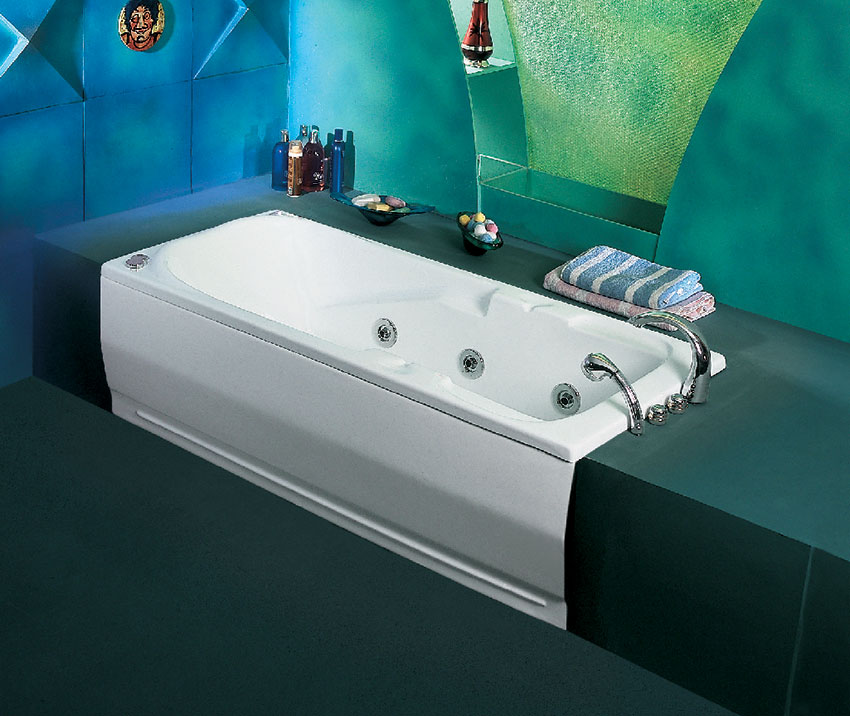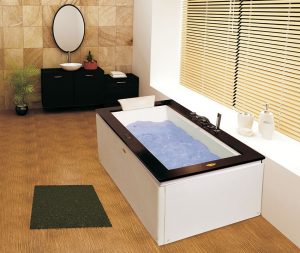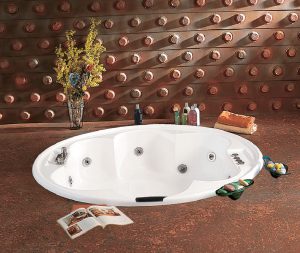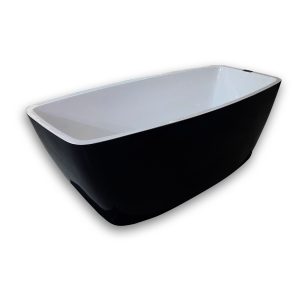Round freestanding tubs are a beautiful addition to any bathroom. They look great and can turn your daily bath into a luxurious experience. But to keep them looking their best, you need to take good care of them. In this post, we’ll share some easy tips to help you clean and maintain your round freestanding tub. With these tips, you’ll be able to keep your tub sparkling clean, prevent stains, and make sure it lasts for years to come.
Daily Care
Taking care of your round freestanding tub doesn’t have to be a big chore. A little daily attention can go a long way in keeping it clean and fresh. Here are some simple things you can do every day to keep your tub in top shape.
First, give your tub a quick rinse after each use. This is as easy as running some water and using the showerhead to rinse away any soap residue or body oils. It only takes a minute, but it can really help prevent buildup over time.
Next, wipe down your tub with a soft cloth. This helps dry up any water droplets that could lead to water spots or mineral buildup. You don’t need any special products for this – a simple microfiber cloth works great.
Lastly, make sure your bathroom has good airflow. After your bath, open a window or run the fan for a bit. This helps dry out the tub and the whole bathroom, which can prevent mold and mildew from growing.
These quick daily habits might seem small, but they can make a big difference. They help keep your tub clean between deeper cleanings and can save you time and effort in the long run.
Weekly Cleaning Routine
While daily care is important, your round freestanding tub also needs a good cleaning each week. This doesn’t have to be a huge task, but it does require a bit more time and effort than your daily wipe-down. Here’s how to do a thorough weekly clean of your tub.
First, let’s talk about cleaning products. It’s important to use the right kind of cleaner for your tub. Look for a pH-neutral cleaner that’s made for bathrooms. These are gentle enough not to damage your tub’s finish but strong enough to clean effectively. Stay away from harsh, abrasive cleaners or scrubbers – these can scratch your tub and make it harder to keep clean in the future.
Now, for the cleaning process itself. Start by applying your chosen cleaner to the tub. You can use a spray bottle or pour it directly onto a soft sponge or cloth. Work in sections, starting at the top of the tub and moving down. This way, you won’t miss any spots.
When you’re cleaning, use gentle, circular motions. There’s no need to scrub hard – let the cleaner do most of the work. Pay extra attention to areas that tend to get dirty, like around the faucets and drain. These spots often collect soap scum and mineral deposits.
After you’ve cleaned the whole tub, it’s time to rinse. Use plenty of clean water to wash away all the cleaning product. You can use a showerhead if you have one, or a bucket of clean water and a soft cloth. Make sure you rinse thoroughly – any leftover cleaner can leave a residue that attracts dirt.
Finally, dry your tub with a soft, clean towel. This prevents water spots and gives your tub a nice shine.
Remember, consistency is key with weekly cleaning. Set aside a regular time each week to clean your tub, and it will become a quick and easy part of your routine.
Dealing with Specific Stains and Issues
Even with regular cleaning, your round freestanding tub might sometimes face specific stains or issues. Don’t worry – most of these problems are easy to fix if you know how. Let’s look at some common issues and how to handle them.
Hard water stains are a frequent problem in many homes. These look like chalky white or gray spots on your tub. They happen when mineral-rich water evaporates and leaves deposits behind. To prevent hard water stains, try to wipe down your tub after each use. If you already have these stains, you can remove them with a mixture of equal parts white vinegar and water. Spray this on the stains, let it sit for about 15 minutes, then wipe and rinse.
Soap scum is another common issue. It looks like a filmy layer on your tub and can make it feel slippery. Soap scum builds up when soap mixes with minerals in water. To prevent it, use liquid body wash instead of bar soap, and rinse your tub well after each use. If you have soap scum buildup, a paste made of baking soda and water can help remove it. Spread the paste on the scum, let it sit for a few minutes, then scrub gently and rinse.
Rust stains can be tricky. They often come from metal objects left on the tub, like shaving cream cans. To prevent rust stains, try to keep metal objects off your tub. If you do get a rust stain, you can try using a mixture of lemon juice and salt. Spread this on the stain, let it sit for a few minutes, then scrub gently and rinse. For tough rust stains, you might need a commercial rust remover made for use on tubs.
Remember, when dealing with any kind of stain, always test your cleaning solution on a small, hidden area first. This helps make sure it won’t damage your tub’s finish. And never mix different cleaning products – this can create dangerous fumes.
With these tips, you should be able to handle most common stains and keep your round freestanding tub looking great.
Maintaining Different Tub Materials
Round freestanding tubs can be made from different materials, and each type needs slightly different care. Let’s look at how to maintain some common tub materials.
Acrylic tubs are popular because they’re lightweight and keep water warm for a long time. To clean an acrylic tub, use a soft cloth or sponge and a mild, non-abrasive cleaner. Avoid anything too harsh or scratchy – even some bath sponges can be too rough for acrylic. A mix of dish soap and warm water works well for regular cleaning. For tougher stains, you can use a paste of baking soda and water. Just remember to rinse well after cleaning to avoid leaving any residue.
Stone resin tubs, also known as solid surface tubs, are durable and have a luxurious look. They’re pretty easy to clean – warm water and mild soap usually do the trick. For deeper cleaning, you can use a non-abrasive bathroom cleaner. Avoid anything acidic, like vinegar or lemon juice, as these can damage the surface over time. After cleaning, it’s a good idea to apply a stone sealer every few years to protect the surface.
Cast iron tubs with enamel coating are classic and long-lasting. They’re tough, but the enamel can chip if you’re not careful. Clean these tubs with a soft sponge and mild, pH-neutral cleaner. Avoid abrasive cleaners or scrubbers, as these can wear down the enamel over time. For tough stains, you can use a mixture of baking soda and water, but don’t let it sit for too long. Always rinse well after cleaning.
No matter what material your tub is made of, there are a few general rules to follow. Always start with the mildest cleaning method and work your way up if needed. Rinse thoroughly after cleaning to remove all soap residue. And dry your tub after cleaning to prevent water spots and mineral buildup.
By using the right cleaning methods for your tub’s material, you’ll keep it looking great and extend its lifespan. If you’re ever unsure about a cleaning product or method, check your tub’s care instructions or contact the manufacturer. It’s always better to be safe than sorry when it comes to caring for your beautiful freestanding tub.
Long-term Maintenance
Keeping your round freestanding tub in good shape isn’t just about daily care and weekly cleaning. There are some things you should do less often to make sure your tub stays in top condition for years to come.
Every few months, give your tub a deep clean. This is like your weekly clean, but more thorough. Use a soft brush to really get into all the nooks and crannies. Pay extra attention to areas you might miss during regular cleaning, like under the rim of the tub or around the overflow drain.
Check the caulk and seals around your tub regularly. Caulk is the rubbery stuff that fills the gaps where your tub meets the floor or wall. Over time, it can wear down or even start to peel away. This can let water seep in where it shouldn’t, causing damage. If you notice any gaps or peeling in the caulk, it’s time to replace it. You can do this yourself with a caulk gun, or call in a pro if you’re not comfortable doing it.
While you’re at it, check for any leaks. Look for water stains on the floor around your tub, or any signs of water damage on nearby walls. Catching leaks early can save you from bigger problems down the line.
Sometimes, it’s a good idea to have a professional look at your tub. They can spot potential issues you might miss and do any repairs that are needed. Think about having a pro check your tub every year or two, especially if it’s getting older.
Remember, taking care of your tub isn’t just about keeping it clean. It’s also about spotting and fixing small problems before they become big ones. With good long-term maintenance, your round freestanding tub can be a beautiful part of your bathroom for many years.
Preventive Measures
They say prevention is better than cure, and that’s true for your round freestanding tub too. There are several things you can do to prevent problems before they start.
If you live in an area with hard water, consider getting a water softener. Hard water is full of minerals that can leave spots and buildup on your tub. A water softener removes these minerals, making it easier to keep your tub clean and preventing damage over time.
For some types of tubs, you might want to use a protective sealant. This is a clear coating that helps protect the surface of your tub. It can make cleaning easier and help prevent stains. But be careful – not all tubs need or should have a sealant. Check with the manufacturer or a professional before applying anything to your tub.
One of the best preventive measures is simply having a regular cleaning schedule. When you clean your tub regularly, dirt and grime don’t have a chance to build up. This makes each cleaning easier and helps prevent tough stains from forming.
You might also want to keep a squeegee in your bathroom. After each bath, you can quickly run the squeegee over the sides of the tub to remove water droplets. This simple step can go a long way in preventing water spots and mineral buildup.
Another good habit is to keep your bathroom well-ventilated. Run the fan during and after your bath, or open a window if you have one. This helps dry out the tub and the whole bathroom, which can prevent mold and mildew growth.
Lastly, be mindful of what you bring into your tub. Avoid using bath oils or products with strong dyes, as these can stain your tub. If you do use these products, clean your tub right after to prevent staining.
By taking these preventive steps, you can save yourself a lot of time and effort in the long run. Your tub will stay cleaner between cleanings, and you’ll be less likely to face tough stains or damage.




